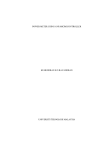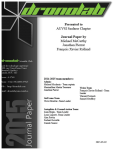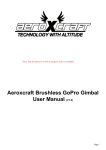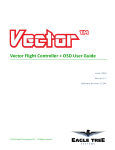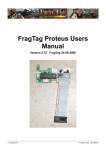Download C25 AND C30 USER MANUAL (REVISION 2)
Transcript
CONTENTS SECTION 01 – BILL OF MATERIAL SECTION 02 – REQUIRED TOOLS SECTION 03 – BEFORE YOU BEGIN SECTION 04 – ARM PREPARATION • CUTTING MULTIROTOR TUBE ARMS SECTION 05 – C25 / C30 ASSEMBLY STEPS • QUICK RELEASE LEVER ASSEMBLY • COUPLING ASSEMBLY • DRILLING THE MULTIROTOR TUBE ARMS • WIRING • COUPLING INSTALLATION • ARM INSTALLATION AND FINE ADJUSTMENT SECTION 06 – PRE-FLIGHT CHECKS SECTION 01 BILL OF MATERIAL QUANTITY PART DESCRIPTION 1 Male Coupling Half (Black anodized aluminum) 1 Female Coupling Half (Black anodized aluminum) 1 Quick Release Lever (Black anodized aluminum) 1 Quick Release Compression Ring (Black anodized aluminum) 1 Threaded Tension Shaft (Black anodized aluminum) 1 Secondary Retention Arm (Red anodized aluminum) 1 Internal Bullet Connector Plug A (White SLS 3D printed plastic) 1 Internal Bullet Connector Plug B (White SLS 3D printed plastic) 6 4mm High Current Bullet Connector Male (Gold plated) 6 4mm High Current Bullet Connector Female (Gold plated) 6 M3 X 8 Socket Head Screw (Stainless Steel) 2 M3 X 16 Socket Head Screw (Stainless Steel) 1 M3 X 20 Socket Head Screw (Stainless Steel) 1 M3 X 25 Cap Head Screw (Stainless Steel) 4 M2.5 X 8 Socket Head Screw (Stainless Steel) 1 M2.5 X 3 Socket Head Screw (Stainless Steel) 3 M3 Nylock Nut (Stainless Steel) 12 M3 X 3 Set Screw (Stainless Steel) 1 Knurled Thumb Nut (Brass / Silver in color) 1 M2.5 Washer (Steel) 1 Washer #8 Size (Aluminum) 1 M3 ID X M4.5 OD Spacer (Brass / Silver in color) 1 Flanged Sleeve #8 Size (White Plastic) 8 M2.5 X 4 Socket Head Screw (Stainless Steel) 1 Side of awesome SECTION 02 REQUIRED TOOLS QUANTITY TOOL DESCRIPTION 1 1.5mm allen driver 1 2mm allen driver 1 2.5mm allen driver 1 5.5mm socket driver 1 Tube of Blue Loctite 1 Soldiering Gun 1 Soldier 1 Flux 1 2mm or 5/64” Diameter Drill Bit 1 Drill 1 Carbon Fiber Cutting Tools (see section 4 /step 1) SECTION 03 BEFORE YOU BEGIN You have purchased the only system on the market that allows you to update an existing static arm craft into a removable arm craft. There is nothing else like it. We spent months of design and testing all for the purpose of making sure you never have a mid air failure at the fault of our product. But, it is absolutely imperative you follow this instruction manual exactly and take your time. The assembly and installation must be done correctly. Don't rush through. Read every step before you begin. If you have any questions please feel free to contact us at [email protected] SECTION 04 ARM PREPARATION Carbon Fiber Cutting Tools: Carbon fiber is not difficult to cut if you use the proper tools. There are a number of different types of tools that can be used to cut your multirotor's arms. It is important that the cutting tool you choose have a cutting edge that is sharp and relatively thin. The tools we have the most success with in our shop are cut-off saws, chop saws, miter saws, and horizontal band saws. These tools allow you to mount the tube at 90 degrees to the cutting edge and cut though the tube very quickly without much effort. These saws can be purchased inexpensively from vendors such a Harbor Freight. We have also had success using a floor standing band saw to cut carbon fiber. But, be warned this type saw may have a tendency to “walk” causing the 'cut face' to be at some other angle than 90 degrees. If you determine you have cut your tubes at something other than perpendicular its very important to place the tube on a right angle sander to clean up the 'cut face' and bring that face back to perpendicular. WARNING! CARBON FIBER POWDER IS DANGEROUS TO YOUR LUNGS. WHEN CUTTING YOUR TUBES BE SURE TO WEAR PROPER PROTECTION AS TO NOT INHAIL THE DUST THAT IS CREATED INTO YOUR LUNGS! CATALYST MACHINEWORKS CAN NOT BE HELD LIABLE FOR ANY INJURIES INCURRED DURING THIS PROCESS. Step1: The C25 and C30 Quick Release Arm System is designed to place the 'break' point of the arm just past the center hub of your craft. This means you must physically cut your carbon fiber tube arms. We suggest you remove the arms from your craft before cutting them. First mark where you will cut the arm. The arm should be cut 31mm from the outer edge of the center hub. It is very important the 'cut face' of the arm be at 90 degrees (perpendicular) to the tube axis. If you notice you have cut your arm at some other angle this can be easily corrected by using a right angle sander. The pictures below represent the short half of the arm after it has been cut, and installed into the center hub of your craft. Step 2: Verify the opposite end of the arms (the long end) has a 'cut face' that is 90 degrees (perpendicular) to the tube axis. The overall final length for this side of the arm is up to you. SECTION 05 C25 / C30 ASSEMBLY STEPS Quick Release Lever Assembly: Step 1: Insert the Quick Release Compression Ring onto the Female Coupling Half. The ring will pop into place. The compression ring can be oriented so the Quick Release Lever opens to the left or right side of the coupling. It is up to you which side of the coupling you wish the lever to open to. Rotate the Compression Ring on the coupling until the holes in the side line up. Position the M2.5 Washer and M2.5 X 3mm Socket Screw into the hole and tighten. Do not over torque the screw. It just needs to be snug. WARNING! IT IS VERY IMPORTANT YOU USE THE M2.5 WASHER OR THE SCREW WILL SCRATCH THE MATING COUPLING HALF. Step 2: Position the Threaded Tension Shaft over the top hole in the Compression Ring and thread in the M3 X 20mm Socket Head Screw. Only turn the screw a few turns into the shaft. Correct adjustment will happen later in the assembly process. Step 3: Insert the M3 ID X M4.5 OD Spacer into the open hole in the Thread Tension Shaft. Hold the spacer in place while you position the Quick Release Lever and then run a M3 X 16 Socket Head Screw through the assembly. Thread a M3 Nylock Nut onto the screw and torque it down. Do not over torque the nut and compress the Quick Release Lever. You want the screw and nut to be free to rotate in the assembly. Coupling Halves Assembly: Step 1: Insert three M3 X 8mm Socket Head Screws into the threaded holes shown below. Do not torque them down at this point. Only thread them into the holes until the head of the screw stops against the coupling ear. At this point you can turn the M3 X 20mm screw in the Threaded Tension Shaft to pull the Quick Release Lever closer to the Compression Ring. But, do not over tighten the screw and apply clamping force to the Compression Ring yet. Step 2: Position the Secondary Retention Arm under the hole specified below and insert an M3 X 16mm Socket Head Screw. Now thread an M3 Nylock Nut onto the end of the screw. Do not torque down the assembly at this point. Step 3: Insert three M3 X 8mm Socket Head Screws into the threaded holes shown below on the Male Coupling Half. Do not torque them down at this point. Only thread them into the holes until the head of the screw stops against the coupling ear. Step 4: Insert the M3 X 25mm Cap Head Screw into the hole specified below. Install the following fasteners as shown going from top to bottom. 1) Aluminum Washer 2) Flanged Plastic Sleeve 3) Knurled Thumb Nut 4) M3 Nylock Nut Drilling the Carbon Fiber Arm Step 1: Make sure the arm is removed from your multirotor. Insert Plug A onto the end of the short arm half. Then install the female coupling half over the same end. Line up the holes in the side of the coupling half with the threaded holes in the side of Plug A. Install a M2.5 X 8 Socket Head Screw into each hole. While pressing the female coupling half towards the arm, torque down the screws on it's ears to clamp the coupling half onto the arm. Step 2: You will notice two holes in the top of the coupling half and two holes in the bottom (4 holes total). Use these holes as a template to drill through the carbon fiber with a 2mm drill bit or 5/64” drill bit. Either size will work. But, make sure the drill bit is new and sharp. Drill through the carbon fiber. GO SLOW and use a moderate speed on the drill with light pressure. Too much pressure and you may end up scratching your C25/C30 once the bit breaks though the tube wall. It should be very easy to drill through the wall. Once the holes are drilled you can remove the coupling half from the arm. The holes you drilled will be used later to accept M2.5 X 4mm screws. Step 3: Insert Plug B onto the end of the long arm half. Then install the male coupling half over the same end. Line up the holes in the front of the coupling half with the holes in the front of Plug B. Install a M2.5 X 8 Socket Head Screw into each hole on the face of the coupling half (2 total). While pressing the male coupling half towards the arm, torque down the screws on it's ears to clamp the coupling half onto the arm. Step 4: You will notice two holes in the top of the coupling half and two holes in the bottom. Use these holes as a template to drill through the carbon fiber with a 2mm drill bit or 5/64” drill bit. Either size will work. But, make sure the drill bit is new and sharp. Drill through the carbon fiber. GO SLOW and use a moderate speed on the drill with light pressure. Too much pressure and you may end up scratching your C25/C30 once the bit breaks though the tube wall. It should be very easy to drill through the wall. Once the holes are drilled you can remove the coupling half from the arm. The holes you drilled will be used later to accept M2.5 X 4mm screws. Wiring: General: There are two plastic plugs in your kit. One that holds the female bullet connectors and one that holds the male bullet connectors. These plugs are designed with an internal feature in the bores that makes it impossible for the connector to be pushed out the rear of the plug. Because this feature is present it requires you to feed your wires in from the back of the plug during soldiering/assembly. These plastic plugs will accept up to 6 bullet connectors. Meaning you can run up to 6 wires through the C25 or C30. This allows for double motor arm configurations where 2 ESC's are used per arm. If you are only using 1 ESC per arm this will allow you to utilize the open plugs for things such as LED lighting installs on the ends of your arm. The bullet connectors will accept up to 12 AWG wires. Install the bullet connectors in the following patterns below based on how many connectors you plan to use: 2 Bullet Connectors: 3 Bullet Connectors: 4 Bullet Connectors: 5 Bullet Connectors: 6 Bullet Connectors: Step 1 (PLUG A): For the purposes of this manual we will display a 6 bullet connector configuration moving forward. But, the assembly steps are identical for any number of connectors you wish to use. The plastic plug which houses the male bullet connectors will be installed on the short arm half that is mounted in your craft's center hub. Cut your wires such that they are long enough to run through the holes in the plug. Leave enough length to allow for soldiering to the bullet connectors. Step 2 (PLUG A): Cut back the insulation on your wires such that when the bullet connector is installed into the plug any open wiring is shielded by the plug. If you cut the insulation back too far you will need to provide protection to the wire by installing heat shrink tube insulation (included in your kit). Its important each wire be insulated from the adjacent wires! Step 3 (PLUG A): Soldier on the male bullet connectors to your wires, one by one. There is an open hole on one side of the connector to facilitate ease of soldiering. It is important to not let much soldier run into the outside of the connector. If too much soldier is deposited on the exterior of the connector you may have trouble pressing the connector into the mating hole in the plastic plug! Step 4 (PLUG A): The bullet connector and its mating hole are designed to be a press fit. Press each bullet connector into the mating hole in the plastic plug. There are some important things to verify when pressing the connector into the hole: a) Orient the open hole AWAY from the set screw. This set screw is designed to seat up against the soft bullet connector material. This effectively locks the connector in place. b) Press the connector in far enough that the lip of the ring fits flush with the face of the plastic plug. Exactly as pictured below. Step 5 (PLUG A): Insert one set screw per bullet connector. DO NOT over torque the set screw against the connector. Simply turn the set screw until it stops, then turn the screw a little farther. The set screw does not require much torque to properly set against the bullet connector. You don't want to strip the threads inside the plastic plug. After all set screws are properly set against the connectors, test fitment by pushing and pulling each connector with your finger. Try your best to pull the connector out of it's bore. If assembled properly, the connectors should not move inside the plug. Step 1 (PLUG B): The plastic plug which houses the female bullet connectors will be installed on the long half of the arm. Cut your wires such that they are long enough to run through the holes in the plug. Leave enough length to allow for soldiering to the bullet connectors. Step 2 (PLUG B): Cut back the insulation on your wires such that when the bullet connector is installed into the plug any open wiring is shielded by the plug. If you cut the insulation back too far you will need to provide protection to the wire by installing heat shrink tube insulation (included in your kit). Its important each wire be insulated from the adjacent wires! Step 3 (PLUG B): Soldier on the male bullet connectors to your wires, one by one. There is an open hole on one side of the connector to facilitate ease of soldiering. It is important to not let much soldier run onto the outside of the connector. If too much soldier is deposited on the exterior of the connector you may have trouble pressing the connector into the mating hole in the plastic plug! Step 4 (PLUG B): The bullet connector and its mating hole are designed to be a press fit. Press each bullet connector into the mating hole in the plastic plug. There are some important things to verify when pressing the connector into the hole: a) Orient the open hole AWAY from the set screw. This set screw is designed to seat up against the soft bullet connector material. This effectively locks the connector in place. b) Press the connector in far enough that its lip fits flush with the face of the plastic plug. Exactly as pictured below. Step 5 (PLUG B): Insert one set screw per bullet connector. DO NOT over torque the set screw against the connector. Simply turn the screw until it stops, then turn the screw a little farther. The set screw does not require much torque to properly set against the bullet connector. You don't want to strip the threads inside the plastic plug. If you have assembled correctly it should be impossible for the connectors to move inside the plug. COUPLING INSTALLATION: Step 1 (HUB SIDE): First install the female coupling half on the short arm near the multirotor center hub. When inserting the coupling half over the arm line up the holes on the side of the coupling with the holes on the side of the plastic plug. Also align the top and bottom holes on the coupling with the holes you drilled in the arm. Step 2 (HUB SIDE): Install M2.5 X 8mm Socket Head Screws into the threaded holes on either side of the coupling. Torque the screws down so they bottom out against the coupling and are snug. Align the holes at the top and bottom of the coupling half with the holes you drilled previously then install a M2.5 X 4mm Socket Head Screw into each hole. Step 3 (HUB SIDE): Apply Blue Loctite to the 4 screws in the ears of the coupling and torque them down. It is important these screws be tight. Step 1 (MOTOR SIDE): Press the plastic plug onto the end of the arm. Then install the male coupling half into the arm over the plug. Align the 2 holes on the plug with the two holes in the coupling half. Step 2 (MOTOR SIDE): Install M2.5 X 8mm Socket Head Screws into the open holes on the face of the coupling. Torque the screws down so they bottom out against the coupling and are snug. Align the holes at the top and bottom of the coupling half with the holes you drilled previously then install a M2.5 X 4mm Socket Head Screw into each hole. Step 3 (MOTOR SIDE): Apply Blue Loctite to the 4 screws in the ears of the coupling and torque them down. It is important these screws be tight. Arm installation and Fine Adjustment: Step 1: The moment you have been waiting for is here! Line up the male to female coupling halves and insert the arm into your multirotor's center hub. Be sure the two “position tabs” on the male coupling half face slide into the slots on the female coupling half interior. Push the arm hard enough to completely seat it. A visual check to determine when the arm is seated correctly is to make sure the face of the female coupling half is almost touching the first set of ears on the male coupling half. The two faces to check are pictured below. They are highlighted green. Step 2: It is of vital importance the quick release lever is properly adjusted to provide adequate clamping force. Proper adjustment is accomplished by turning the adjustment screw pictured in blue below. Rotate the screw until the compression ring firmly clamps the male coupling half when the quick release lever is in the 'Closed Position'. Quick Release Adjustment Screw Closed Position Open Position As a rule of thumb you should set the adjustment screw such that you begin to feel resistance on the quick release lever at the following locations in the ‘Open Position’ for the C25 and C30. C25 C30 Step 3: Tighten the Nylock Nut located under the Secondary Retention Arm. Apply enough torque until the nut lightly touches the bottom of the arm. You want this arm to be able to rotate freely but with a slight resistance. If the arm cannot rotate you have applied too much torque to the nut. Step 4: Rotate the Secondary Retention Arm and snap it into place. There is a Knurled Thumb Nut located just below this arm. It's purpose is to hold the arm in place. Adjust the Nylock Nut until there is a slight gap between the Aluminum Washer and the bottom of the Secondary Retention Arm. The Secondary Retention Arm is “unlocked” when the thumb nut is turned counterclockwise and resting against the Nylock Nut. The Secondary Retention Arm is “locked” when the thumb nut is turned clockwise and pressing firmly against the arm. Unlocked Locked SECTION 06 PRE-FLIGHT CHECKS General: It is important to add the C25 / C30 pre-flight checks to your existing check list. Perform these checks every time you fly. 1. Inspect the interior bullet connectors on both the male and female coupling halves. Make sure nothing has moved or appears damaged. Also verify no foreign objects have become lodged inside the coupling. 2. Verify no fasteners have backed out. 3. Verify the Quick Release Lever is applying proper clamping force when in it's “closed position”. Now go fly. And enjoy being able to remove the arms from your multirotor!














































